Full-Scale Model Tests of Two Box-Type Soil–Steel Structures with Different Crown and Haunch Radii
Abstract
:1. Introduction
2. Experimental Scheme
2.1. Description of the Full-Scale Model
2.2. Test Program and Experimental Procedure
3. Mechanical Behavior of BTSSS during Backfilling
3.1. Structure Deformation during Backfilling
3.2. Stress and Internal Force during Backfilling
3.3. Earth Pressure during Backfilling
4. Mechanical Behavior of BTSSS under Live Loading
4.1. Structure Deformation under Live Loading
4.2. Internal Force under Live Loading
4.3. Earth Pressure under Live Loading
5. Numerical Simulation and Results
5.1. Numerical Modeling
5.2. Modeling Verification
5.2.1. Modeling Verification for Backfilling Process
5.2.2. Modeling Verification under Live Load
5.3. Parametric Analysis
6. Design Method Modification
7. Conclusions
- (1)
- The upward deformation and the stress in the middle of the sidewall are the largest when the backfill reaches the haunch. The BTSSS with the straight crown (Structure A) has less upward deformation than the BTSSS with the curved crown (Structure B). The haunch stress and bending moment of Structure A are significantly greater than those of Structure B.
- (2)
- After the backfill reaches the haunch, the deformation begins to reverse. At the end of backfilling, the deflection, bending moment, and earth pressure of Structure A are 1.3 times, 1.2 times, and 2.2 times those of Structure B, respectively. Structure B promotes more even haunch and crown bending moments and earth pressures through stronger soil–steel interactions.
- (3)
- The deformation of Structure A under the live load is greater than that of Structure B at the same cover depth. The deformation of Structure A is twice that of Structure B when the cover depth is 60 cm. The crown bending moment of Structure A is twice that of Structure B when the cover depth is 30 cm.
- (4)
- The span and arch height of the cross-section are the most important factors, which need to be designed emphatically.
- (5)
- Based on the CHBDC specification, a more accurate calculation formula for calculating the bending moment during the backfilling process of the BTSSS was proposed. Incorporating the crown and haunch radii into the revised calculation formula, the formula has wider applicability.
Author Contributions
Funding
Institutional Review Board Statement
Informed Consent Statement
Data Availability Statement
Acknowledgments
Conflicts of Interest
References
- Maleska, T.; Beben, D. Behaviour of Soil–Steel Composite Bridges under Strong Seismic Excitation with Various Boundary Conditions. Materials 2023, 16, 650. [Google Scholar] [CrossRef]
- Miśkiewicz, M.; Sobczyk, B.; Tysiac, P. Non-Destructive Testing of the Longest Span Soil-Steel Bridge in Europe—Field Measurements and FEM Calculations. Materials 2020, 13, 3652. [Google Scholar] [CrossRef]
- Embaby, K.; El Naggar, M.H.; El Sharnouby, M. Performance of large-span arched soil–steel structures under soil loading. Thin-Walled Struct. 2022, 172, 108884. [Google Scholar]
- Che, H.; Tong, L.; Liu, S.; Yang, Q. Field investigation on the mechanical performance of corrugated steel utility tunnel (CSUT). J. Constr. Steel Res. 2021, 183, 106693. [Google Scholar] [CrossRef]
- AASHTO (American Association of State Highway and Transportation Officials). LRFD Bridge Design Specifications; AASHTO: Washington, DC, USA, 2017. [Google Scholar]
- CHBDC (Canadian Highway Bridge Design Code). S6-19—12th Edition; Canadian Standards Association International: Mississauga, ON, Canada, 2019. [Google Scholar]
- Duncan, J.M.; Seed, R.B.; Drawsky, R.H. Design of corrugated metal box culverts. In Culverts: Analysis of Soil Culvert Interaction and Design; Naomi, K., Ed.; Transportation Research Board: Washington, DC, USA, 1985; pp. 33–41. [Google Scholar]
- AS/NZS 2041.1:2011; Buried Corrugated Metal Structures—Part 1: Design Methods. Council of Standards Australia and New Zealand: Sydney, Australia, 2011.
- Byrne, J.H. Analysis of Corrugated Steel Box-Type Culvert. Master’s Thesis, Ohio University, Columbus, OH, USA, 1987. [Google Scholar]
- Flener, E.B. Testing the response of box-type soil-steel structures under static service loads. J. Bridge Eng. 2010, 15, 90–97. [Google Scholar] [CrossRef]
- Flener, E.B. Response of long-span box type soil-steel composite structures during ultimate loading tests. J. Bridge Eng. 2009, 14, 496–506. [Google Scholar] [CrossRef]
- Flener, E.B. Soil-steel interaction of long-span box culverts-performance during backfilling. J. Geotech. Geoenviron. 2010, 136, 823–832. [Google Scholar] [CrossRef]
- Pettersson, L.; Flener, E.B.; Sundquist, H. Design of soil–steel composite bridges. Struct. Eng. Int. 2015, 25, 159–172. [Google Scholar]
- McCavour, T.C.; Byrne, P.M.; Morrison, T.D. Long-span reinforced steel box culverts. Transport. Res. Rec. 1998, 1624, 184–195. [Google Scholar] [CrossRef]
- Machelski, C.; Korusiewicz, L. Testing the load capacity of a soil-steel box structure. Roads Bridges 2018, 17, 181–191. [Google Scholar]
- Wysokowski, A. Influence of single-layer geotextile reinforcement on load capacity of buried steel box structure based on laboratory full-scale tests. Thin-Walled Struct. 2021, 159, 107312. [Google Scholar] [CrossRef]
- Korusiewicz, L.; Kunecki, B. Behaviour of the steel box-type culvert during backfilling. Arch. Civ. Mech. Eng. 2011, 11, 637–650. [Google Scholar] [CrossRef]
- Abdel-Sayed, G.; Salib, S.R. Minimum depth of soil cover above soil-steel bridges. J. Geotech. Geoenviron. 2002, 128, 672–681. [Google Scholar] [CrossRef]
- Sobotka, M.; Lydba, D. Live load effect in soil-steel flexible culvert: Role of apparent cohesion of backfill. Eur. J. Environ. Civ. Eng. 2022, 26, 620–634. [Google Scholar] [CrossRef]
- Maleska, T.; Beben, D. Behaviour of soil-steel composite bridge with various cover depths under seismic excitation. Steel Compos. Struct. 2022, 42, 747–764. [Google Scholar]
- Maleska, T.; Beben, D. Effect of the soil cover depth on the seismic response in a large-span thin-walled corrugated steel plate bridge. Soil Dyn. Earthq. Eng. 2023, 166, 107744. [Google Scholar] [CrossRef]
- Pettersson, L.G. Full Scale Tests and Structural Evaluation of Soil Steel Flexible Culverts with Low Height of Cover. Ph.D. Thesis, KTH Royal Institute of Technology, Stockholm, Sweden, 2007. [Google Scholar]
- JTG D60-2015; General Specifications for Design of Highway Bridges and Culverts. China Communication Press: Beijing, China, 2015.
- Kreuzer, M. Strain Measurement with Fiber Bragg Grating Sensors; HBM: Darmstadt, Germany, 2006; 12p. [Google Scholar]
- Beben, D. Numerical study of performance of soil-steel bridge during soil backfilling. Struct. Eng. Mech. 2012, 42, 571–587. [Google Scholar]
- Elshimi, T.M.; Moore, I.D. Modeling the effects of backfilling and soil compaction beside shallow buried pipes. J. Pipeline Syst. Eng. 2013, 4, 04013004. [Google Scholar]
- Zhang, Y.; Liu, B.; Meng, L. Structural behavior and soil arching state of underground corrugated steel utility tunnel. J. Constr. Steel Res. 2023, 203, 107798. [Google Scholar]
- Kang, J.; Parker, F.; Yoo, C.H. Soil–structure interaction for deeply buried corrugated steel pipes Part II: Imperfect trench installation. Eng. Struct. 2008, 30, 588–594. [Google Scholar] [CrossRef]
- Kang, J.; Im, H.; Park, J.S. The effect of load reduction on underground concrete arch structures in embedded trench installations. Tunn. Undergr. Space Technol. 2020, 98, 103240. [Google Scholar] [CrossRef]
- Elshimi, T.; Mak, A.; Brachman, R.; Moore, I. Behaviour of a deep-corrugated large-span box culvert during backfilling. In Proceedings of the 64th Canadian Geotechnical Conference, Toronto, ON, Canada, 2–6 October 2011. [Google Scholar]
- Zheng, G.; Huang, J.; Diao, Y.; Ma, A.; Su, Y.; Chen, H. Formulation and performance of slow-setting cement-based grouting paste (SCGP) for capsule grouting technology using orthogonal test. Constr. Build. Mater. 2021, 302, 124204. [Google Scholar] [CrossRef]
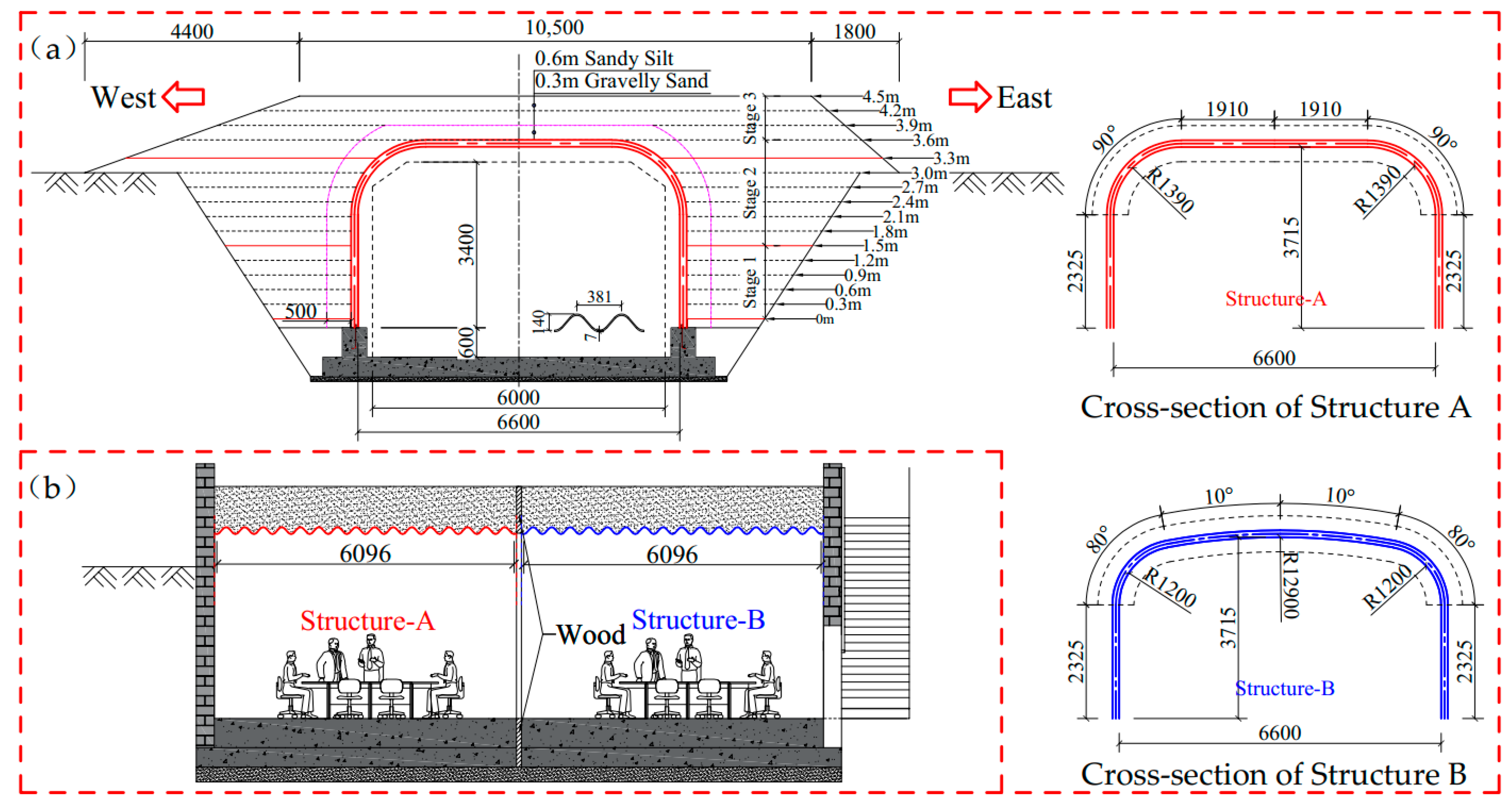
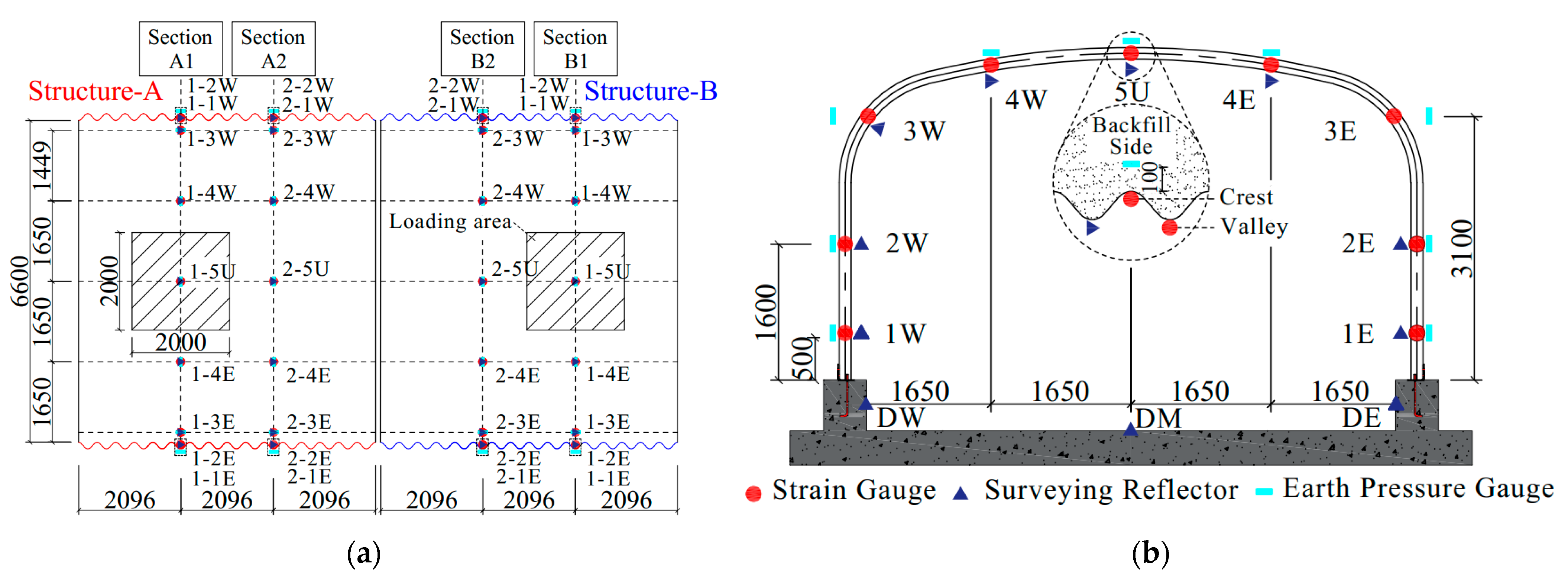






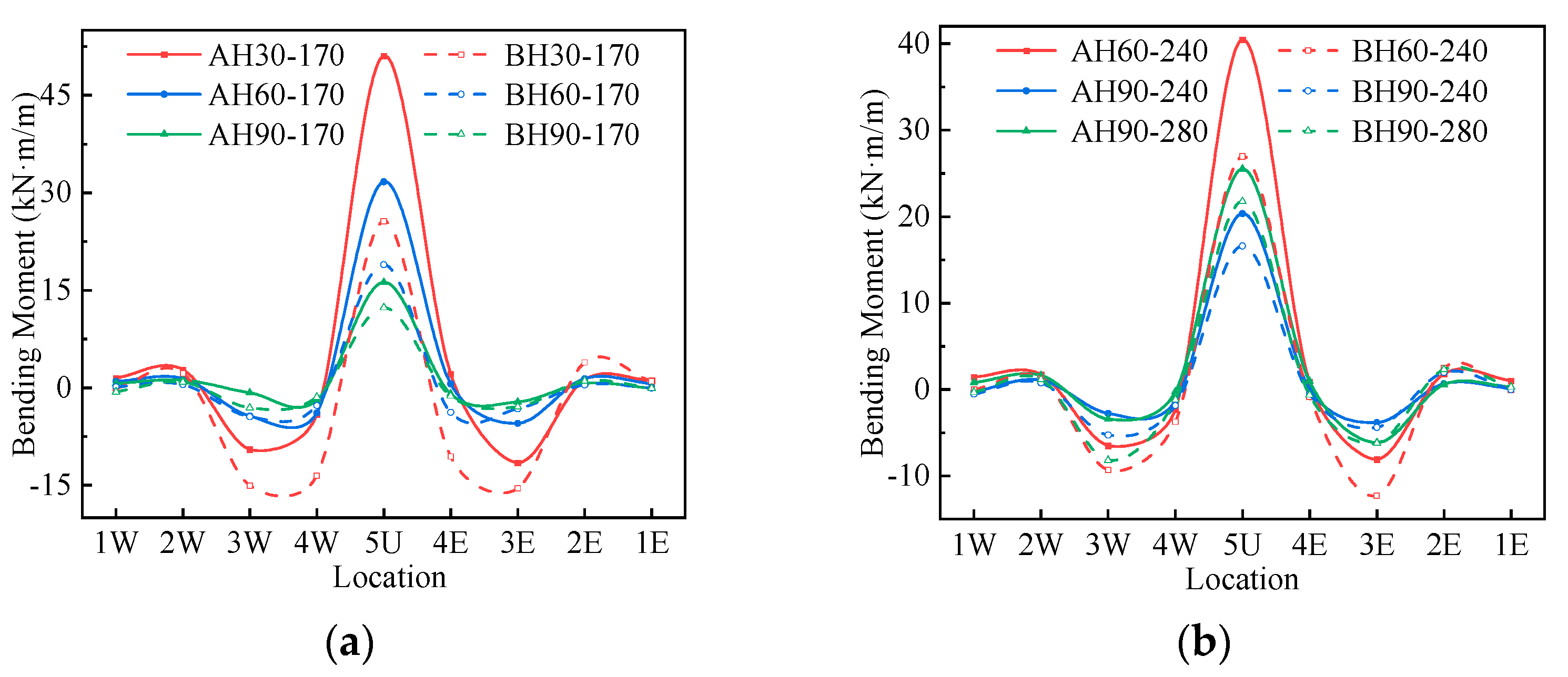

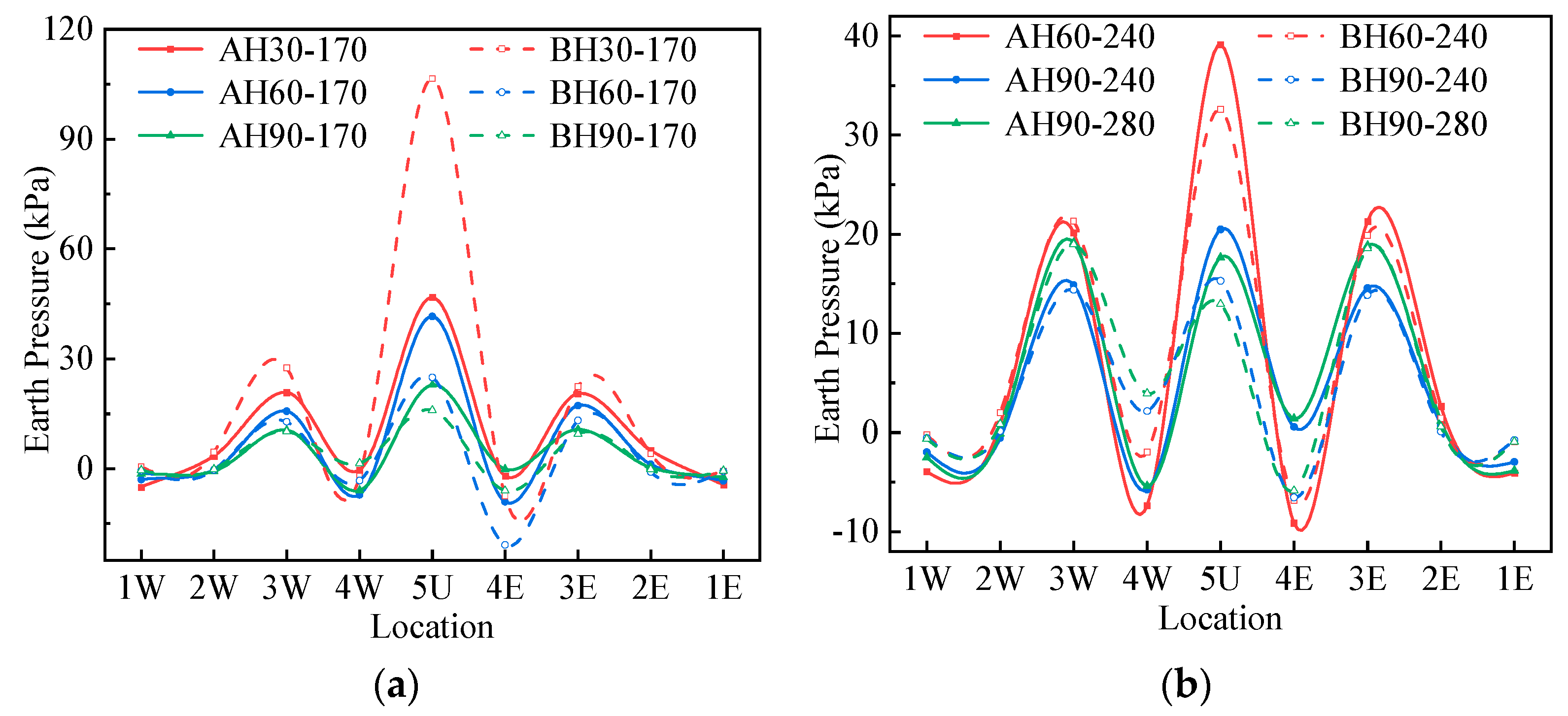

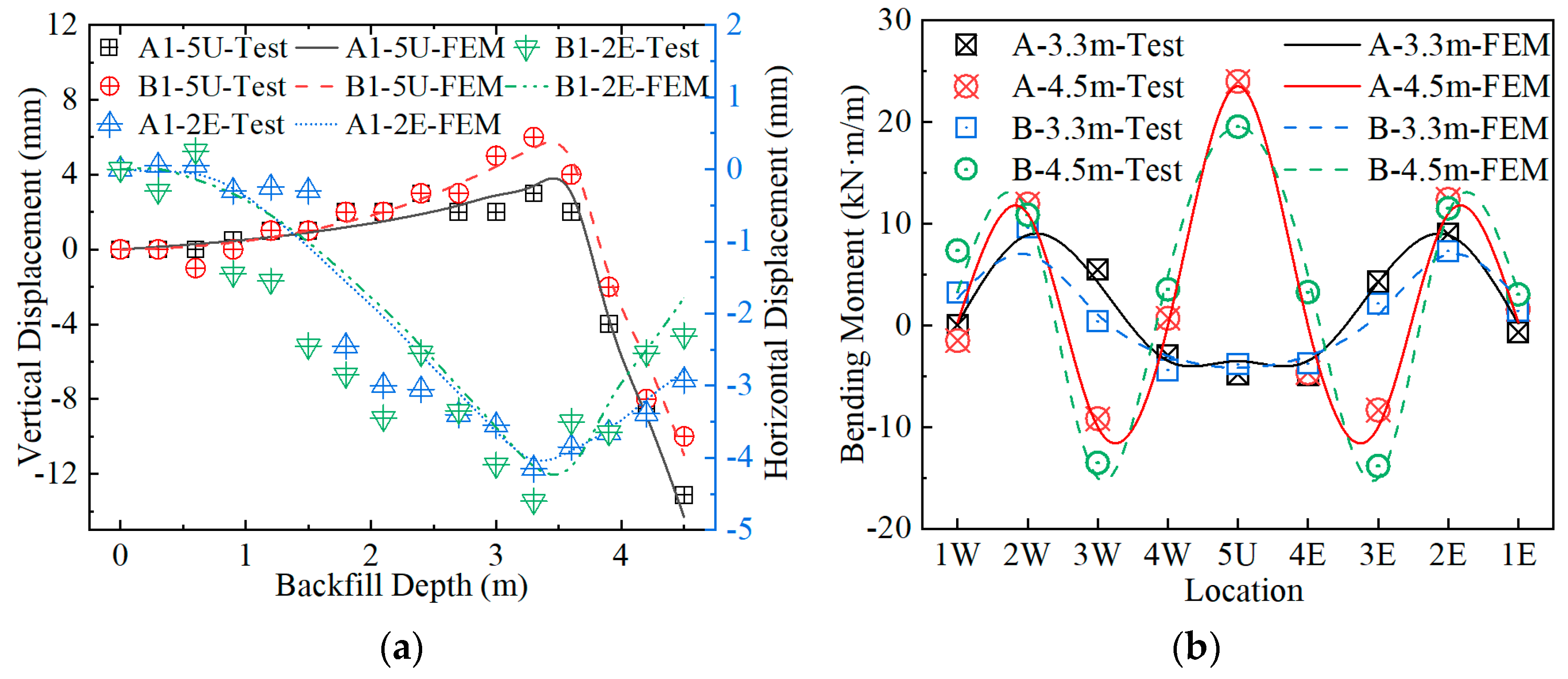
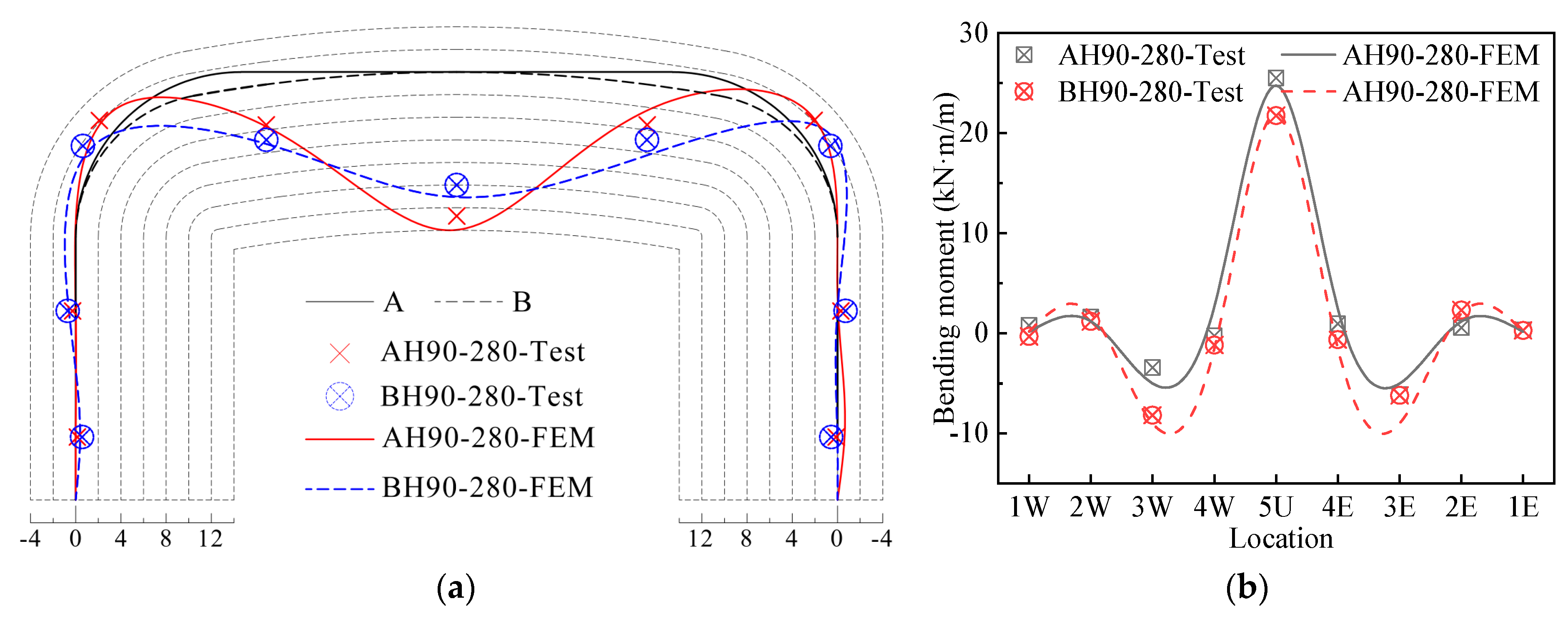
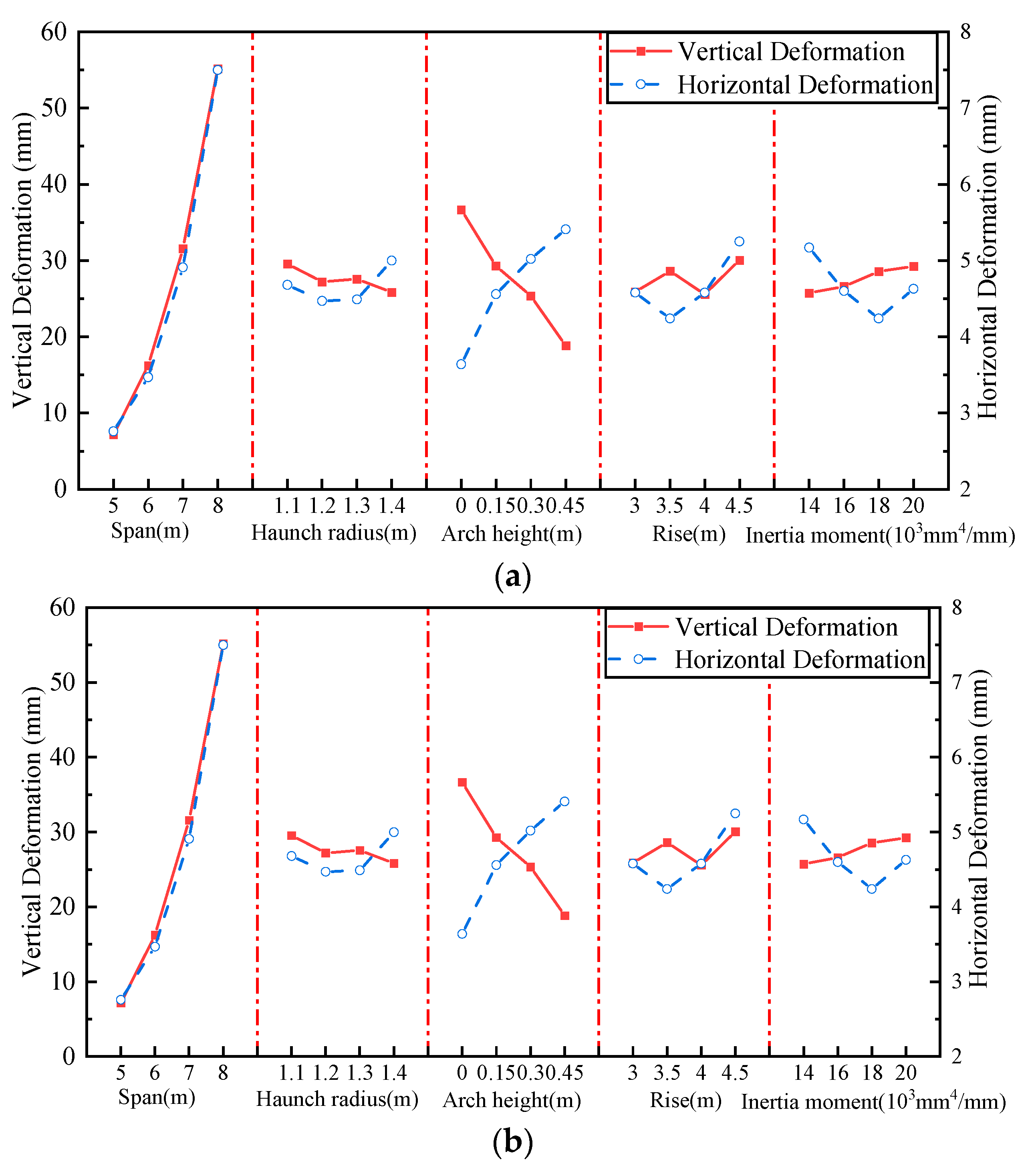
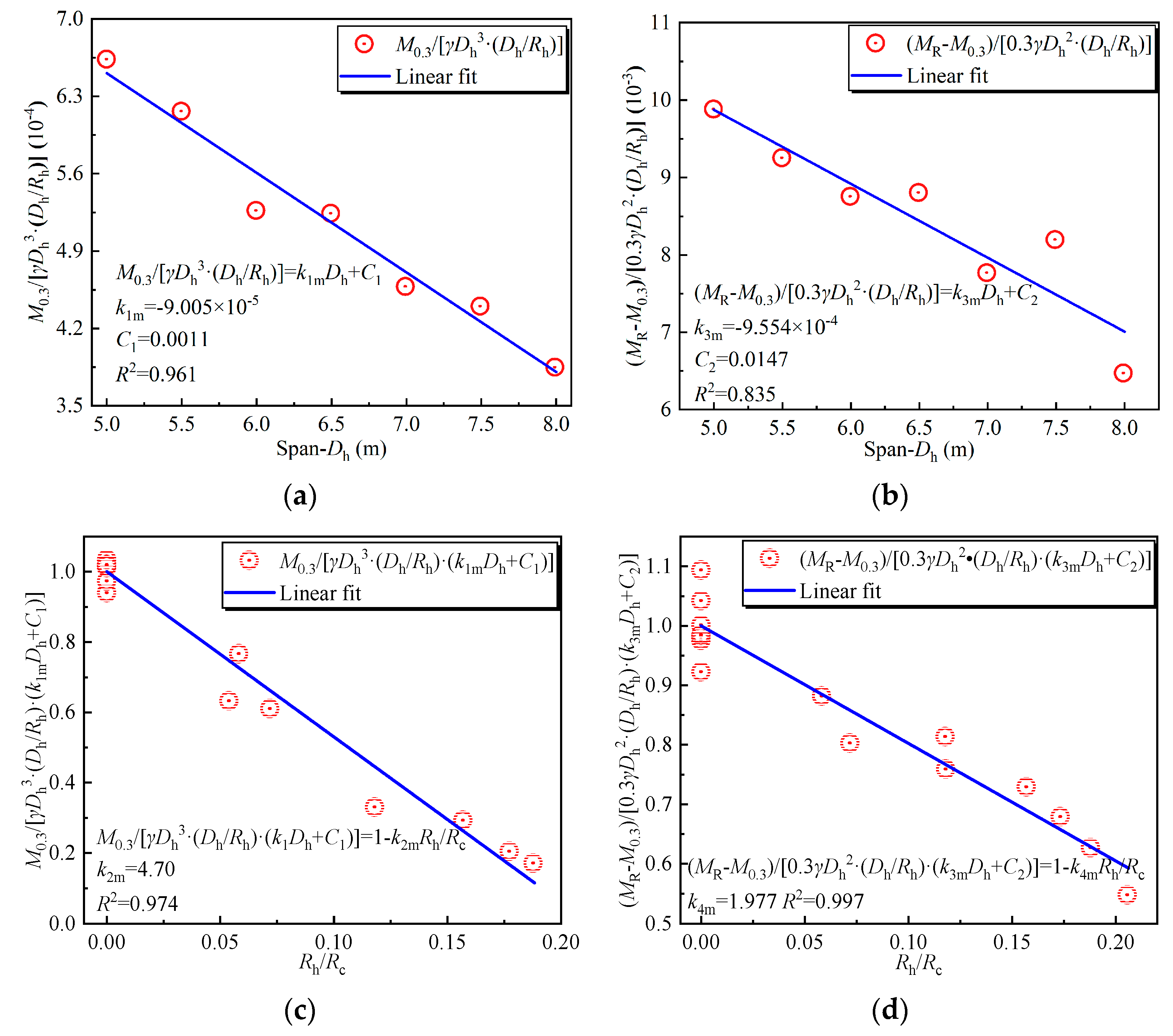
| Properties | Sandy Silt | Gravelly Soil | Native Soil | Concrete Foundation |
|---|---|---|---|---|
| Density (kg/m3) | 1796 | 2021 | 1900 | 2400 |
| Elastic modulus (MPa) | 18.82 | 62.45 | 30 | 30,000 |
| Poisson ratio | 0.3 | 0.3 | 0.3 | 0.2 |
| Cohesion (kPa) | 1.7 | 13.7 | 1.7 | - |
| Friction angle (°) | 24.48 | 40.43 | 24.48 | - |
| Dilatancy angle | 4 | 10 | 4 | - |
| Cross-Section Geometric Parameters | Level | Factor | ||||
|---|---|---|---|---|---|---|
| A (m) | B (m) | C (m) | D (m) | E (mm4/mm) | ||
 | 1 | 5 | 3 | 1.1 | 0.00 | 14,005.36 |
| 2 | 6 | 3.5 | 1.2 | 0.15 | 16,072.34 | |
| 3 | 7 | 4 | 1.3 | 0.30 | 18,158.81 | |
| 4 | 8 | 4.5 | 1.4 | 0.45 | 20,265.75 | |
| Test Plan | Dead Load Bending Moment (kN·m/m) | Live Load Bending Moment (kN·m/m) | Deformation (mm) | ||||||||
|---|---|---|---|---|---|---|---|---|---|---|---|
| Schemes | A | B | C | D | E | Crown | Haunch | Crown | Haunch | Vertical | Horizontal |
| 1 | 1 | 1 | 1 | 1 | 1 | 5.52 | 7.46 | 24.71 | 20.76 | 14.83 | 2.19 |
| 2 | 1 | 2 | 2 | 2 | 2 | 0.71 | 5.21 | 21.28 | 17.53 | 8.72 | 2.00 |
| 3 | 1 | 3 | 3 | 3 | 3 | 5.11 | 2.00 | 18.22 | 14.87 | 4.06 | 2.45 |
| 4 | 1 | 4 | 4 | 4 | 4 | 8.22 | 1.51 | 13.58 | 10.54 | 1.01 | 4.41 |
| 5 | 2 | 1 | 2 | 3 | 4 | 3.49 | 6.46 | 26.15 | 22.52 | 13.78 | 3.53 |
| 6 | 2 | 2 | 1 | 4 | 3 | 0.20 | 5.08 | 22.91 | 19.90 | 11.65 | 3.41 |
| 7 | 2 | 3 | 4 | 1 | 2 | 7.08 | 10.52 | 31.93 | 24.76 | 20.77 | 2.65 |
| 8 | 2 | 4 | 3 | 2 | 1 | 3.40 | 9.42 | 27.52 | 22.80 | 18.72 | 4.3 |
| 9 | 3 | 1 | 3 | 4 | 2 | 2.87 | 6.08 | 25.10 | 20.98 | 20.33 | 5.35 |
| 10 | 3 | 2 | 4 | 3 | 1 | 5.03 | 8.13 | 28.02 | 23.60 | 26.96 | 5.69 |
| 11 | 3 | 3 | 1 | 2 | 4 | 12.60 | 18.41 | 42.59 | 36.81 | 35.08 | 4.72 |
| 12 | 3 | 4 | 2 | 1 | 3 | 15.09 | 20.39 | 48.24 | 39.93 | 43.93 | 3.86 |
| 13 | 4 | 1 | 4 | 2 | 3 | 17.08 | 19.09 | 47.58 | 40.33 | 54.6 | 7.23 |
| 14 | 4 | 2 | 3 | 1 | 4 | 23.62 | 25.85 | 59.87 | 49.62 | 67.15 | 5.87 |
| 15 | 4 | 3 | 2 | 4 | 1 | 6.67 | 12.84 | 33.52 | 27.41 | 42.39 | 8.48 |
| 16 | 4 | 4 | 1 | 3 | 2 | 13.09 | 20.75 | 45.03 | 40.06 | 56.62 | 8.41 |
Disclaimer/Publisher’s Note: The statements, opinions and data contained in all publications are solely those of the individual author(s) and contributor(s) and not of MDPI and/or the editor(s). MDPI and/or the editor(s) disclaim responsibility for any injury to people or property resulting from any ideas, methods, instructions or products referred to in the content. |
© 2024 by the authors. Licensee MDPI, Basel, Switzerland. This article is an open access article distributed under the terms and conditions of the Creative Commons Attribution (CC BY) license (https://creativecommons.org/licenses/by/4.0/).
Share and Cite
Wu, F.; Liu, B.; Sun, W.; Sun, H.; Zhang, S. Full-Scale Model Tests of Two Box-Type Soil–Steel Structures with Different Crown and Haunch Radii. Materials 2024, 17, 1710. https://doi.org/10.3390/ma17081710
Wu F, Liu B, Sun W, Sun H, Zhang S. Full-Scale Model Tests of Two Box-Type Soil–Steel Structures with Different Crown and Haunch Radii. Materials. 2024; 17(8):1710. https://doi.org/10.3390/ma17081710
Chicago/Turabian StyleWu, Fei, Baodong Liu, Weiming Sun, Haibo Sun, and Shun Zhang. 2024. "Full-Scale Model Tests of Two Box-Type Soil–Steel Structures with Different Crown and Haunch Radii" Materials 17, no. 8: 1710. https://doi.org/10.3390/ma17081710





